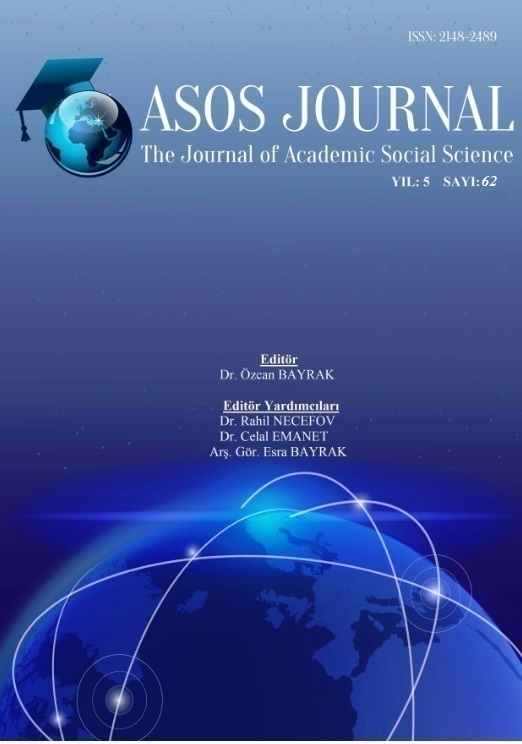Author :
Abstract
Doğa'nın gerçekliğinde yer alan estetik buluşlar, sadece sanatçının ilgisini çekmemiştir. Sanatçı öncelikle doğadaki nesnelere Antik Yunan'dan itibaren araştırılması gereken bir bilim gibi yaklaşmış; doğaya ve insan anatomisine karşı yapıt üzerinden çözümlemeye gitmiştir. Bilimdeki gelişmeler sanatçının da dünya'da ki nesnelere farklı bir gözle bakmasını sağlarken; zaman içerisinde sanatçının bilimsel gelişmelere hayranlığı, özellikle Rönesans'la beraber doruk noktasına ulaşır. Bu dönemde nesnel gerçekliğin içerisinde barındırdığı matematik ve analitik ilkeler; sanatçıların temel dayanağı olmuştur. Sanatın bilimsel gelişmelere ilgisinin yanı sıra; bilim adamı da, estetik değerlere karşı ilgi göstermiş, nesnel gerçeklikle ilgilenirken; karşılaştığı estetik verilere hayranlığını gizlememiştir. Doğa gerçekliğinde ki matematiksel oran, güzel ve estetik nesnenin oluşmasında bir ölçüt olmuştur. Böylece bilimde ki gelişen her aşama, doğadaki güzelliklerin ve uyumun peşindeki sanatçının haricinde, bilim adamı da estetiksel ölçütlerin peşine düşmüş ve doğadaki yasaları faklı bir algıyla kavramaya çalışmıştır.Yunanlılar'dan itibaren bilimsel araştırmalar sanatçıların ilgisini çekmiştir. Çünkü sanatçıların nesnel gerçekliğe olan ilgisi Yunanlılarla birlikte başlamış ve Rönesans'ta tekrar sanatçının ilgi odağı olmuştur. Bilimsel gelişmelerin ardı ardına kesilmez ilerleyişi, Rönesans'tan sonra gelen sanatçıları da etkiler. Rönesans sanatçıları, formları doğru çizme kaygısına düşerek; matematiksel bir algıyla, geometrik ilişkilerle temellenen bir güzellik anlayışı içinde bulunurlar. Rönesans'da ki bu gerçeklik arayışı bir zorunluluk şeklinde diğer ressamlara da yayılmıştır. Perspektifin keşfi sadece nesnel arayışta olan sanatçıların değil; manzara ressamlarının da ilgi odağı olmuştur. Manzara ressamları, doğa gerçekliğini, doğa gözlemine dayalı perspektif kurallarıyla biçimlendirerek; sanatı doğa yasalarına yönelik bir araştırma alanı gibi algılamışlardır. Sanatın ilerleyiş sürecinde ise kübizm akımının bilimsel, matematiksel ve teknolojik temele dayanan araştırmaları; sanatın metodolojisine yön vermiştir. Tarihsel süreçte sanatın; olgusal gerçeklik yönüyle bilimle ilgilendiğini gördük. Bilimdeki her gelişme toplumu etkilediği gibi sanatçıyı da etkilemiştir. Bu anlamda sanat tarihinde bir çok sanatçının bilimsel gelişmelerle paralel hareket ettiğini ve toplumu dönüştüren bilimin sanatı da dönüştürmesi kaçınılmaz bir süreç olmuştur.
Keywords
Abstract
Aesthetic discoveries found in the reality of nature have not only caught the attention of artists. Since Ancient Greece, the artist has primarily approached objects in nature as a science that should be researched; analysing nature and human anatomy based on a comparison of art work. While developments in science have made it possible for the artist to see objects on Earth from a different perspective, over time, the artist’s admiration for scientific developments, especially with Renaissance, has reached its peak. Mathematical and analytical principals held under an objective reality in this period have been the artists’ main point of reference. Apart from art’s interest in scientific developments; scientists have also shown interest in aesthetic values, and while dealing with objective reality, they have not concealed their admiration for the aesthetic data they have come across. The mathematical ratio in the reality of nature has been a criterion in the formation of the beautiful and aesthetic object. Thus, apart from the artist who is after the beauty and harmony in nature, the scientist has also pursued aesthetic ratios and tried to grasp laws of nature from a different perspective, in every step in the development of science. As of the Ancient Greeks, scientific research has awoken artists’ interests. This interest in objective reality started with the Greeks, and with Renaissance, once again became the focal point of the artist. The successive advancement of scientific developments effects artists who have come after Renaissance too. Renaissance artists concerned with drawing correct forms find themselves in an understanding of beauty that is founded by geometric relations and a mathematical perception. The search for reality in Renaissance has spread to other artists as a form of necessity. The discovery of perspective has not only been the focus of artists seeking objectivity but also landscape artists. By shaping the reality of nature with the rules of perspective based on observing nature, landscape artists have perceived art as a field of research towards the laws of nature. Cubism’s research based on scientific, mathematical and technological foundations have steered the methodology of art during its advancement process. In the historical course of art, we have seen that it has been concerned with science as a factual reality. As every development in science impacts society, it has also impacted the artist. In this sense, many artists have acted in parallel to scientific developments and it has been an inevitable process in which science that has transformed societies has also transformed art.





